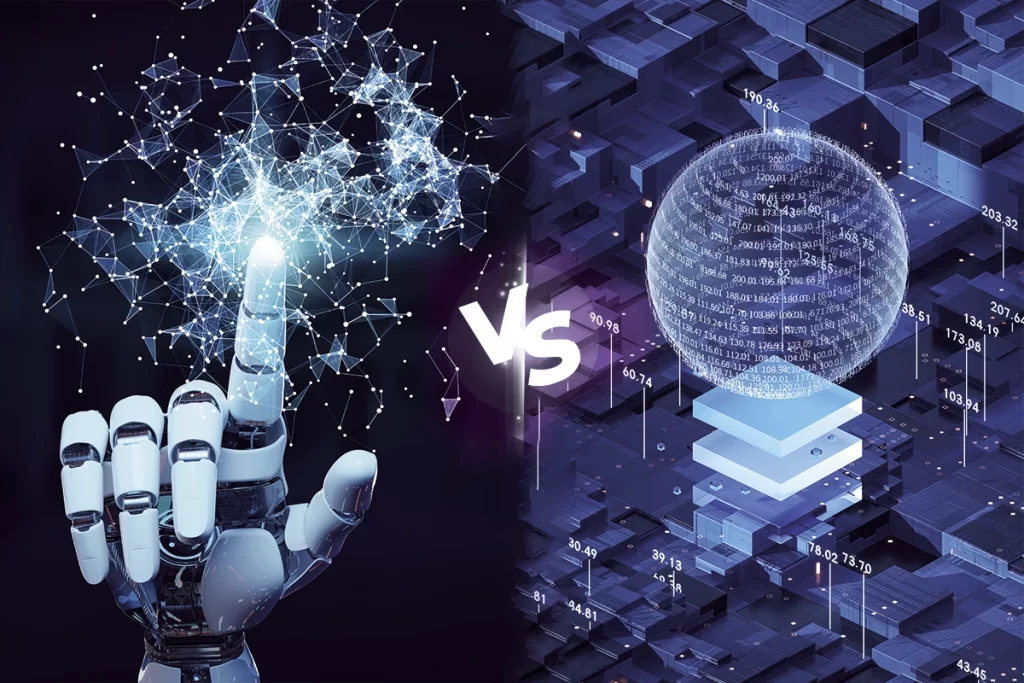Machine learning (ML) and other forms of artificial intelligence have made it possible for robots to mimic human intelligence by learning from people’s behavior.
When it comes to automating business processes, two of the most crucial technologies are robotic process automation (RPA) and machine learning (ML).
Is it really necessary to compare RPA with ML, which both aim to automate processes? This question can be answered by comparing and contrasting these various uses.
It is becoming increasingly difficult to tell individual technologies apart as they develop. There are some parallels between the technologies, but there are also important distinctions.
RPA and machine learning are just some of the cutting-edge technologies; the end result is the hyper-automation of business processes. Individually, each one accomplishes a distinct automated task.
What is Machine Learning?
Machine learning is a subfield of AI that focuses on enabling systems to learn and develop autonomously through exposure to data. It seeks to mimic human learning through the use of data and algorithms, with the goal of producing increasingly competent results.
The ML improves the predictive power of software without requiring any changes to the original code. It is well known that the algorithms used in machine learning make use of past data in order to make predictions about future output values.
Machine learning is widely applied; some examples are recommendation engines, fraud and spam detection, spam filtering, malware threat identification, BPA, and predictive maintenance.
What is Robotic Process Automation (RPA)?
The software technology known as robotic process automation (RPA) simplifies the creation, deployment, and management of software robots that mimic human movements while interacting with digital systems and programs. With RPA, millions of bots can now collaborate with humans in the workplace.
Software robots, like humans, are capable of a wide range of defined behaviors, such as screen reading, key completion, system navigation, data identification and extraction, and so on.
Its purpose is to simplify operations throughout a company. RPA software is designed to carry out tasks traditionally performed by humans.
In robotic process automation, the “robot” is a software robot that runs on a real or virtual machine.
Difference Between AI and RPA
In the realm of business process automation, RPA and ML are two distinct subsets. RPA is process-driven, while ML is data-driven. RPA is designed to perform mundane, repetitive, simple tasks like receiving emails and storing files. ML is most suited for handling unstructured data, such as that found in a sales order, for example. RPA works well when the business model and process being automated are both consistent and unchanging, but ML is the way to go when quick judgments are needed during the process.
Unlike RPA, Machine Learning solutions can modify their behavior in response to changes in a process. Robotic process automation (RPA) was developed to assist businesses in automating routine processes, and it excels at those that are rule-based and traverse organizational boundaries. ML, is data-driven and needs large amounts of high-quality data to function properly. An appropriate ML algorithm is trained with data, allowing it to complete the task more quickly and accurately than a human. The demand for speed and accuracy in the completion of a static business process is likely to be met by RPA, but ML may be required if the procedure requires making judgments on the go, which would be outside the reach of an RPA solution.
Like different businesses use different forms when submitting invoices, robotic process automation providers can script every action for the bot or robot, but they cannot train the bot to extract the necessary data from each invoice.
On the other hand, AI is capable of accurately interpreting the different invoices.
Conclusion:
It’s evident that the true value of RPA and ML does not rest in isolated uses, despite the fact that they refer to separate technologies and automation methodologies. Instead, businesses of the future will benefit from intelligent automation that pools these resources. Your company will be able to achieve more with far less work if its systems can collaborate, make decisions, and convert the results into useful business insights.
Do you wish to use RPA and ML to their fullest extent? Explore the realm of automation further with AI/ML Development Company to learn about the potential changes it might bring to your company.




